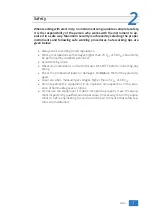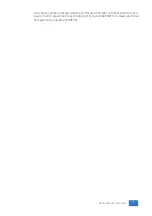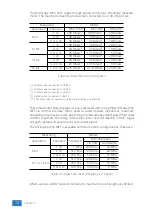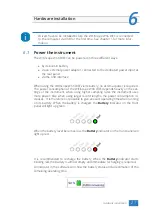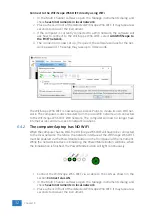
Figure 4.10: The effect of the sampling rate
The sampling rate must be higher than 2 times the highest frequency in the input
signal. This is called the
Nyquist frequency
. Theoretically it is possible to recon-
struct the input signal with more than 2 samples per period. In practice, 10 to
20 samples per period are recommended to be able to examine the signal thor-
oughly.
4.3.1
Aliasing
When sampling an analog signal with a certain sampling rate, signals appear in the
output with frequencies equal to the sum and difference of the signal frequency
and multiples of the sampling rate. For example, when the sampling rate is 1000
Sa/s and the signal frequency is 1250 Hz, the following signal frequencies will be
present in the output data:
Multiple of sampling rate
1250 Hz signal
-1250 Hz signal
...
-1000
-1000 + 1250 =
250
-1000 - 1250 = -2250
0
0 + 1250 = 1250
0 - 1250 = -1250
1000
1000 + 1250 = 2250
1000 - 1250 = -250
2000
2000 + 1250 = 3250
2000 - 1250 =
750
...
Table 4.4: Aliasing
As stated before, when sampling a signal, only frequencies lower than half the
sampling rate can be reconstructed. In this case the sampling rate is 1000 Sa/s,
so we can we only observe signals with a frequency ranging from 0 to 500 Hz. This
means that from the resulting frequencies in the table, we can only see the 250
Hz signal in the sampled data. This signal is called an
alias
of the original signal.
If the sampling rate is lower than twice the frequency of the input signal,
aliasing
will occur. The following illustration shows what happens.
Introduction
17
Summary of Contents for WiFiScope WS6
Page 1: ...WiFiScope WS6 DIFF User manual USB Network WiFi Battery power TiePie engineering...
Page 6: ...IV...
Page 8: ...2 Chapter 1...
Page 10: ......
Page 14: ...8 Chapter 3...
Page 27: ...Figure 4 15 over compensated Introduction 21...
Page 28: ...22 Chapter 4...
Page 31: ...Figure 5 3 Driver install Finished Driver installation 25...
Page 32: ...26 Chapter 5...
Page 58: ...TiePie engineering WiFiScope WS6 DIFF instrument manual revision 2 27 February 2020...

